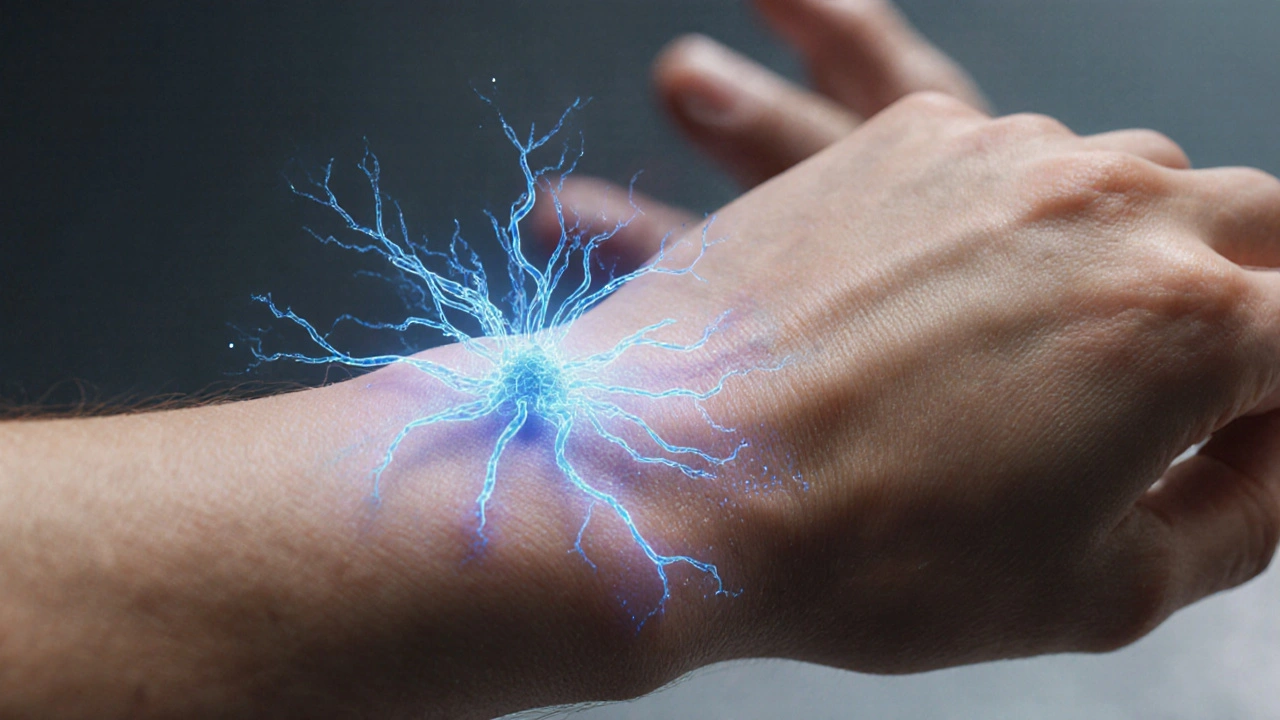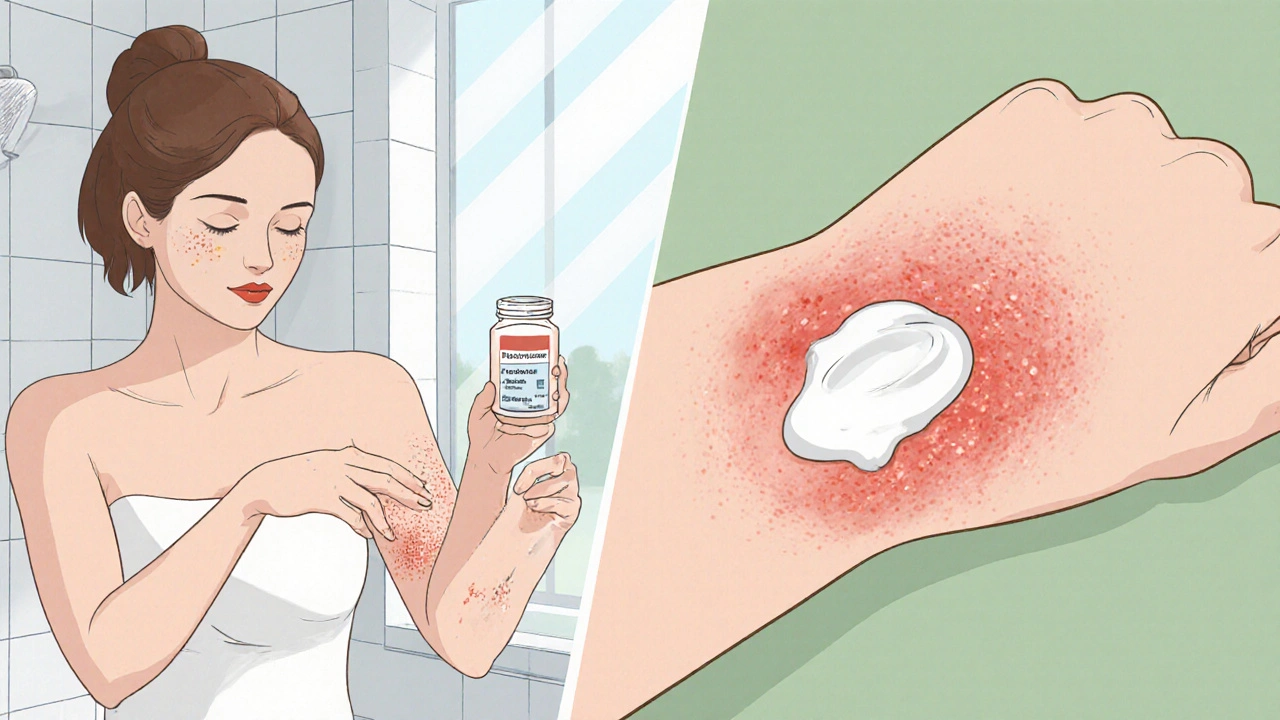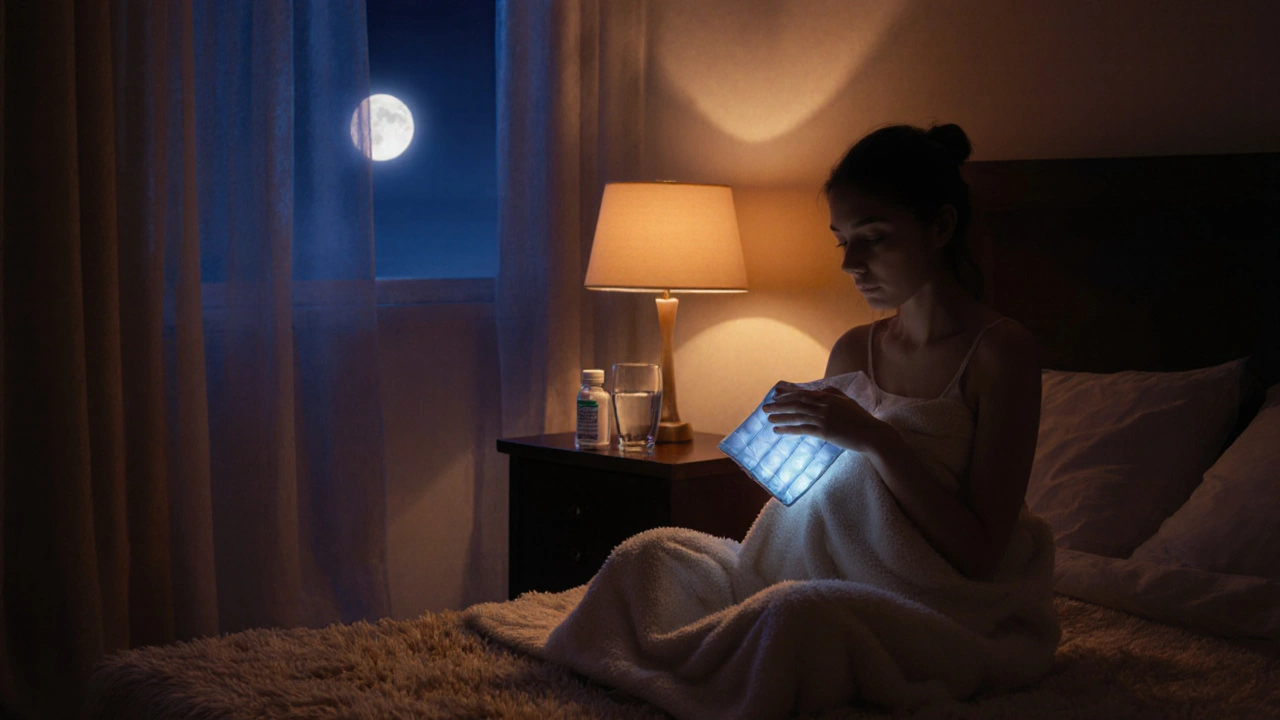
Skin Itching Cause Identifier
Possible Causes & Treatments
Quick Take
- Dry skin tops the list - hydrate fast with a fragrance‑free moisturizer.
- Eczema and psoriasis flare with inflammation; low‑potency steroids help.
- Contact dermatitis is a reaction to something touching your skin - rinse and avoid the trigger.
- Scabies and fungal infections need prescription creams; over‑the‑counter won’t cut it.
- If itching lasts more than two weeks or spreads quickly, see a doctor.
Ever found yourself stuck in a marathon of scratching, only to wonder "why does my skin feel like sandpaper?" You’re not alone. Skin itching (medical term: pruritus) is an uncomfortable sensation that triggers the urge to scratch, often signaling an underlying skin or systemic issue. Below we break down the ten most common culprits, why they happen, and practical steps you can take tonight to break the cycle.
What Exactly Is Pruritus?
Pruritus isn’t a disease; it’s a symptom. Your nerves fire a signal that your brain interprets as "itch." The signal can start in the epidermis (outer skin layer) or be sent from deeper organs like the liver or kidneys. Knowing where the signal originates helps you pick the right remedy.
1. Dry Skin (Xerosis)
Dry skin is a lack of moisture in the stratum corneum, often worsened by low humidity, hot showers, or harsh soaps. In Perth’s winter, indoor heating can strip away natural lipids, leaving your skin tight and itchy.
- How to treat: Apply a fragrance‑free moisturizer within three minutes of bathing. Look for ingredients like ceramides, glycerin, and hyaluronic acid.
- Use a humidifier to keep indoor humidity around 45%.
- Avoid hot water; lukewarm is best.
2. Eczema (Atopic Dermatitis)
Eczema is a chronic inflammatory skin condition characterized by red, scaly patches that itch intensely. Genetics, allergens, and stress can trigger flare‑ups.
- Start with a gentle, soap‑free cleanser.
- Apply a low‑potency topical corticosteroid (e.g., 1% hydrocortisone) to active patches twice daily for up to two weeks.
- Consider a nighttime moisturizer containing colloidal oatmeal to soothe while you sleep.
3. Psoriasis
Psoriasis is an autoimmune disorder that speeds up skin cell turnover, producing silvery‑scale plaques that can itch or burn. Triggers include stress, alcohol, and certain medications.
- Over‑the‑counter coal‑tar or salicylic acid shampoos help scalp lesions.
- Prescription vitamin D analogues (e.g., calcipotriene) reduce scaling.
- Light therapy (UVB) is an effective clinic‑based option for widespread disease.
4. Contact Dermatitis
Contact dermatitis occurs when a substance directly irritates or sensitizes the skin, leading to redness and itching. Common culprits: nickel jewelry, fragrances, latex gloves.
- Rinse the area with cool water for 15 minutes.
- Avoid the offending product; keep a list of known irritants.
- If inflammation persists, apply a mid‑strength steroid cream (e.g., triamcinolone 0.1%).
5. Scabies
Scabies is a contagious mite infestation that burrows under the skin, causing nightly itching especially between the fingers and on the waistline. It spreads through close skin‑to‑skin contact.
- Prescription 5% permethrin cream applied overnight is the gold standard.
- All household members and close contacts should be treated simultaneously.
- Wash bedding and clothing at 60°C or seal in a bag for a week.

6. Fungal Infections (Tinea)
Fungal infection commonly called ringworm or tinea, appears as circular, scaly patches that itch and may crack. Warm, moist environments - like gym lockers - are breeding grounds.
- Apply an over‑the‑counter azole cream (e.g., clotrimazole 1%) twice daily for 2-4 weeks.
- Keep the area dry; use talc powder if needed.
- Replace old shoes and wear breathable socks.
7. Allergic Reactions (Urticaria/Hives)
Allergic reaction often shows up as raised, red welts that itch and can appear anywhere on the body. Triggers range from foods to insect stings.
- Take an oral antihistamine (e.g., cetirizine 10mg) to reduce itch within an hour.
- Identify and avoid the allergen; keep a food or exposure diary.
- Severe cases may need a short course of oral steroids - consult a doctor.
8. Medication Side Effects
Some prescription drugs, especially opioids, cholesterol‑lowering agents, and certain antibiotics, can provoke itching without a rash.
- Do not stop medication abruptly; discuss alternatives with your prescriber.
- Topical moisturizers and non‑sedating antihistamines can provide relief.
- If itching is unbearable, your doctor may switch to a different class.
9. Systemic Diseases (Liver, Kidney, Thyroid)
When internal organs malfunction, bile salts or uremic toxins can accumulate, triggering generalized pruritus.
- Blood tests for liver enzymes (ALT, AST), renal function (creatinine), and thyroid hormones (TSH) give clues.
- Treating the underlying disease often resolves the itch.
- In the meantime, cool baths with colloidal oatmeal can calm symptoms.
10. Stress & Anxiety
Psychological stress releases cortisol and histamine, which can heighten skin sensitivity.
- Practice mindfulness or short breathing exercises when you feel the urge to scratch.
- Regular moderate exercise reduces overall stress hormones.
- If anxiety is chronic, a mental‑health professional can suggest coping strategies.
Summary Table: Causes, Typical Signs, First‑Line Treatment
| Cause | Typical Signs | First‑Line Treatment |
|---|---|---|
| Dry skin | Tight, flaky skin; worst after shower | Moisturizer with ceramides + humidifier |
| Eczema | Red patches, weeping, intense itch | Hydrocortisone 1% + emollient |
| Psoriasis | Silvery plaques, sometimes burning | Topical vitamin D analogue or coal‑tar shampoo |
| Contact dermatitis | Localized redness, swelling near irritant | Rinse, avoid trigger, apply triamcinolone 0.1% |
| Scabies | Nocturnal itching, burrows in web spaces | Permethrin 5% cream overnight |
| Fungal infection | Ring‑shaped, scaly patches | Clotrimazole 1% cream 2‑4weeks |
| Allergic reaction | Urticaria, welts, sometimes swelling | Cetirizine 10mg orally |
| Medication side effect | Generalized itch without rash | Consult prescriber; antihistamine |
| Systemic disease | Itch all over, often night‑time | Treat underlying liver/kidney/thyroid issue |
| Stress/anxiety | Psychogenic itch, worsens with tension | Mindfulness, exercise, possible therapy |
General Self‑Care Tips to Reduce Any Itch
- Keep nails short; a trimmed nail is less likely to break skin.
- Cool compresses (a clean, damp cloth for 5minutes) calm nerve firing.
- Wear breathable, cotton fabrics; avoid wool or synthetic blends that trap heat.
- Stay hydrated - aim for 2L of water daily; skin cells need water to stay supple.
When to Seek Professional Help
If any of the following apply, book an appointment:
- Itch persists > 2weeks despite home care.
- Severe redness, swelling, or pus appears.
- Fever, weight loss, or night sweats accompany the itch.
- Rapid spread to multiple body areas.
Dermatologists can perform a skin scraping, patch test, or blood work to pinpoint the cause and prescribe stronger therapies if needed.

Frequently Asked Questions
Can stress really make my skin itch?
Yes. Stress releases histamine and cortisol, both of which can sensitize skin nerves. Simple breathing exercises or a short walk can lower the itch within minutes.
Why does my skin itch more at night?
Body temperature drops at night, which can heighten nerve activity. Also, fewer distractions mean you notice the sensation more. A cool compress before bed can help.
Are over‑the‑counter creams enough for eczema?
Mild eczema often improves with fragrance‑free moisturizers and 1% hydrocortisone. If flare‑ups persist beyond a week, see a dermatologist for stronger prescription options.
How long does scabies treatment take?
Permethrin cream is applied overnight and washed off in the morning. Symptoms usually fade within 2-3weeks, but all close contacts need treatment at the same time to prevent reinfestation.
Can I use the same moisturizer for dry skin and eczema?
A fragrance‑free, ceramide‑rich cream works well for both. When eczema flares, add a thin layer of a low‑potency steroid before the moisturizer.
Itching is annoying, but you don’t have to live with it. Identify the trigger, follow the right treatment, and you’ll be back to smooth, calm skin in no time.

Leah Hawthorne
October 3, 2025 AT 09:27I’ve been itching (literally) at the dry‑skin part of this guide. Your tip about slapping on a ceramide‑rich lotion within three minutes is spot on – I tried it after a hot shower and my skin actually felt smoother for hours. Also, a humidifier is a game‑changer in winter, especially if you live in a dry climate. Keep those simple, low‑cost fixes front‑and‑center; they help the average joe who isn’t ready to see a dermatologist yet.
Just remember to reapply after washing.
Brian Mavigliano
October 6, 2025 AT 18:47Honestly, most of these “tips” are just marketing fluff.
Emily Torbert
October 10, 2025 AT 04:07Wow, this article really hits home – I’ve dealt with eczema flare‑ups for years and the low‑potency steroid suggestion actually works for me. I love the reminder to use a gentle, soap‑free cleanser; many people don’t realize how harsh regular body wash can be. The nighttime oatmeal moisturizer is a nice touch too, because my skin feels so much calmer while I sleep. Keep the tone friendly; it makes the medical stuff less scary for folks like me.
Rashi Shetty
October 13, 2025 AT 13:27The comprehensive nature of this guide is commendable, yet it falls short in addressing the nuanced pathophysiology behind each condition. For instance, the discussion on psoriasis could benefit from elaborating on the role of Th17 cells and IL‑23 inhibitors, which are now standard in systemic therapy. Moreover, while the article mentions humidifiers, it neglects to specify optimal relative humidity ranges (approximately 45‑55%). Readers would also appreciate guidance on patch testing for contact dermatitis, a critical step before commencing topical steroids. The recommendation of over‑the‑counter azole creams for tinea is accurate, yet it should caution against misuse on facial lesions where irritation risk is higher. Additionally, the systemic disease section omits mention of cholestatic pruritus, a common hepatic cause that often requires bile‑acid sequestrants. Finally, the advice on stress‑induced itch could be bolstered by citing evidence‑based interventions such as cognitive‑behavioral therapy. Overall, the article serves as a solid introductory resource but would greatly benefit from deeper clinical insight and specific quantitative guidance.
Queen Flipcharts
October 16, 2025 AT 22:47While your emphasis on avoiding irritants is appropriate, the tone could be more directive. Explicitly stating that patients should discontinue use of known allergens immediately would reduce ambiguity. Also, a brief note on the appropriate duration for steroid use would enhance safety.
Yojana Geete
October 20, 2025 AT 08:07Hold up, the drama around scabies is real! That “overnight permethrin” line is pure gold – I’ve seen whole families get cured in a single night. But don’t forget to mention that itching can linger for weeks after treatment, which freaks people out. Also, a tiny tip: toss everything in a dryer on high heat for 20 minutes to kill any lingering mites. Trust me, the relief is worth the extra laundry.
Jason Peart
October 23, 2025 AT 17:27First off, kudos for highlighting the emotional toll that relentless itching can exact – it’s more than just a physical nuisance. When I was battling a severe eczema flare, the itch was relentless, keeping me up at night and making me feel like I was walking on a sandpaper carpet. The first step I took was to prioritize a consistent moisturization routine: a thick, fragrance‑free ointment applied within three minutes of bathing, like the article suggests, which dramatically reduced the transepidermal water loss. I also introduced a humidifier set to about 50% humidity; the ambient moisture helped my skin retain hydration and reduced the tight, itchy feeling considerably.
Beyond the basics, I found that a short course of a low‑potency corticosteroid, such as hydrocortisone 1%, applied twice daily to active patches for up to two weeks, provided quick, noticeable relief without the side‑effects associated with stronger steroids. It’s crucial, however, to taper off the steroid gradually to prevent rebound flaring.
Another vital piece of the puzzle was stress management. I began a simple mindfulness routine, spending five minutes each morning focusing on deep breathing. The calming effect reduced my cortisol spikes, which, as the article notes, can exacerbate itchiness. Pairing this with light, regular exercise – even a brisk 20‑minute walk – helped regulate my overall hormone levels and improved my sleep quality, which is essential because lack of sleep worsens skin barrier dysfunction.
From a dietary standpoint, staying well‑hydrated was a game‑changer. I aimed for at least two liters of water per day, which kept my skin cells plump and less prone to cracking. I also cut back on known inflammatory triggers like excessive dairy and refined sugars; within a few weeks, I noticed less redness and itching.
For those dealing with chronic itch from systemic issues, such as liver or kidney disease, I’d advise regular blood work to monitor relevant markers and to discuss with a physician the possibility of using bile‑acid sequestrants or cholestyramine, which can bind pruritogenic substances.
Lastly, a practical tip: keep your nails trimmed short and consider wearing cotton gloves at night if you find yourself scratching in your sleep. This simple barrier can prevent secondary infections and skin damage.
In summary, a multi‑pronged approach-consistent moisturization, appropriate steroid use, environmental humidity control, stress reduction, hydration, and mindful lifestyle adjustments-can collectively tame the itch monster. Stick with it, and you’ll likely see a gradual but steady improvement in both comfort and skin health.
Mithun Paul
October 27, 2025 AT 02:47The article neglects the importance of differential diagnosis.
Sandy Martin
October 30, 2025 AT 12:07The list of treatments is fairly accurate, but I would add that any topical steroid should be limited to two weeks to avoid tachyphylaxis. Also, the suggestion to use a humidifier is great; just ensure it’s cleaned regularly to prevent mold growth.
Steve Smilie
November 2, 2025 AT 21:27One cannot help but admire the sleek presentation, yet the content feels like a perfunctory tour through dermatology’s safety brochure. A dash of original insight would elevate this from bland to brilliant.
Josie McManus
November 6, 2025 AT 06:47Good read, but the advice on over‑the‑counter antifungals needs a warning: improper use can foster resistance.
Heather Kennedy
November 9, 2025 AT 16:07Consider incorporating HPA‑axis modulation into the stress‑itch discussion for a more comprehensive view.
Janice Rodrigiez
November 13, 2025 AT 01:27Excellent compilation! For anyone dealing with dry skin, adding a barrier‑repair serum that contains niacinamide can boost ceramide synthesis and further soothe itching.
Roger Cardoso
November 16, 2025 AT 10:47Isn't it odd that the article skips over the role of gut microbiota in pruritus?
barry conpoes
November 19, 2025 AT 20:07While microbial considerations are interesting, most readers need concrete, actionable steps now. Emphasizing proven treatments over speculative links keeps the guide practical.
John Price Hannah
November 23, 2025 AT 05:27Let me unpack the emotional avalanche that accompanies chronic itch, because the physiological descriptors alone don’t capture the lived reality. When you’re tormented by an incessant pruritic sensation, your brain enters a hyper‑alert state, perpetually primed for discomfort. This hyper‑vigilance fuels a feedback loop: the more you focus on the itch, the stronger the signal becomes, and the more you scratch, the deeper the skin damage, which releases additional inflammatory mediators. Over time, this vicious cycle can lead to secondary infections, scarring, and even pigment changes, which further erode self‑esteem.
Psychologically, individuals often experience heightened anxiety and feelings of helplessness; the itching becomes a silent intruder that invades every quiet moment, disrupting sleep and impairing concentration. The resulting fatigue can diminish work performance and strain interpersonal relationships, as loved ones may not comprehend the invisible torment.
From a neuro‑immune perspective, the release of cytokines such as IL‑31 and nerve growth factor amplifies the pruritic pathways, while stress hormones like cortisol modulate the skin’s barrier function, making it more permeable to irritants. Addressing the itch therefore demands a multimodal approach: topical barrier repair, systemic anti‑inflammatory agents when indicated, and, critically, behavioral interventions to break the itch‑scratch loop. Cognitive‑behavioral therapy (CBT) has demonstrated efficacy in reducing itch perception by training patients to reframe their focus and employ relaxation techniques.
Practically, start with the fundamentals: moisturize immediately after bathing, keep nails trimmed, and use cool compresses to dampen the nerve firing. Next, incorporate antihistamines at night if histamine‑mediated pathways are suspected, but be mindful of potential sedation. For inflammatory dermatoses, a short course of topical steroids or calcineurin inhibitors can curtail flare‑ups, but always taper under medical guidance to avoid rebound.
When systemic causes are at play, such as cholestatic liver disease or renal insufficiency, targeted therapies like bile‑acid sequestrants or dialysis optimization become necessary. Meanwhile, lifestyle tweaks-regular moderate exercise, adequate hydration, and a balanced diet rich in omega‑3 fatty acids-can modulate systemic inflammation and improve skin health.
Finally, foster a supportive environment: share your experience with trusted friends or support groups, as social validation can alleviate the isolation that chronic itch often breeds. In sum, recognizing the itch as both a physiological and psychological phenomenon, and tackling it on both fronts, offers the best chance for lasting relief.
Echo Rosales
November 26, 2025 AT 14:47All that drama, yet a simple antihistamine could have been the headline.
Elle McNair
November 30, 2025 AT 00:07I appreciate the balanced tone here – it acknowledges both medical facts and personal experiences without sounding preachy. Let’s keep sharing tips and supporting each other on the road to itch‑free skin.
Dennis Owiti
December 3, 2025 AT 09:27Good info, but dont forget to check med side effects.